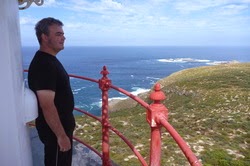Saturday, October 10, 2015
In Certain Circles by Elizabeth Harrower (2014)
I'll admit that I had what is possibly a peculiar fantasy concerning this one. It was slated for publication in 1971 and then withdrawn, after which its author remained silent, so it has long been one of those 'lost' novels which may never have seen the light of day. Harrower had arguably been Australia's premier female writer of the 50s and 60s, alongside Patrick White as the main male. So it has been anticipated at a somewhat higher pitch. My odd fantasy concerns the likening I can feel between Harrower's style and that of many mid-century proponents from other Anglo cultures - writers like Elizabeth Taylor and Hortense Calisher. They have a spare poetic density which is a superb vehicle for insight and guarded emotional effect. And of course I feel the debt that style owes to vanguard authors like Virginia Woolf; my fantasy involved the fact that Woolf was not successful in her 1941 suicide attempt, that she continued to work alongside her husband Leonard at the Hogarth Press, that she mentored younger English writers like Taylor. And then, a year after Leonard's death in 1969, when she was 88, she took up the fifth novel of a fine Australian as her first commission after the grief had laid her off for a few months, and the rest was history, both in terms of that author's reputation being expanded, and of Woolf's becoming a pioneering sole female proprietor of a publishing house. Silly really, but fun to think about. The main characters here don't go through a huge plot-arc, though the story is more eventful than might first be anticipated. Mid-century, a well-off brother and sister, he back from the war and tender, she wide-eyed and just setting out in the world, take up a less fortunate pair and find that the friendship lasts. Their circles are very well-heeled, and all sorts of possibilities come to them with ease, but Harrower is at pains to point out the fact that this is not dehumanising, it simply creates its own topography in terms of the emotions and tensions that resonate through their lives - such challenges as we all have in common, but differently expressed. Agonies and triumphs, marriages, collapses, punctuate the picture as it progresses, magnified by Harrower's intense insight. By the time we reach the late 60s and early 70s, at the end of the book, the four are all more or less dissatisfied, and wrangling each other, along with partners and children, in tangled streams of stultified intent and misunderstanding. A slightly unbelievable accidental mistake by one of them blows apart these problems; the sediments really kick up in their pool. The end shows those murks redescending in a new arrangement - not a sense of immature release, but rather a wiseing-up, an understanding breaking through some, but not all, blockages. It is not the plot though that marks this book out - like those aforementioned contemporaries, it is the writing of these humanities that proves Harrower a great exponent of the modern mind.
Subscribe to:
Post Comments (Atom)

No comments:
Post a Comment